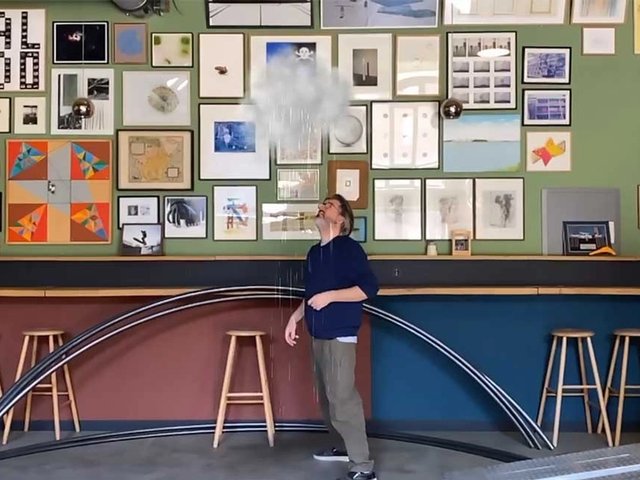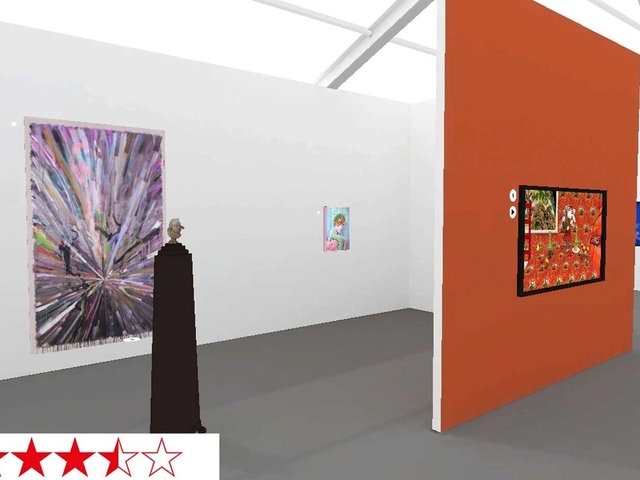The Art Newspaper's XR Panel
What exactly is extended reality (XR) and how is it being used in art? We bring together an international group of experts in the field to review and make sense of the cutting-edge, digital work that artists, museums, galleries and app-makers are creating across the spectrum of XR—from augmented to virtual reality.
Each XR review gives an overview of a project and a statement from the creators before our expert panel rate it based on ease of use, how good the art is, the medium-specific qualities it employs and whether it breaks new ground. Read all our XR reviews here.
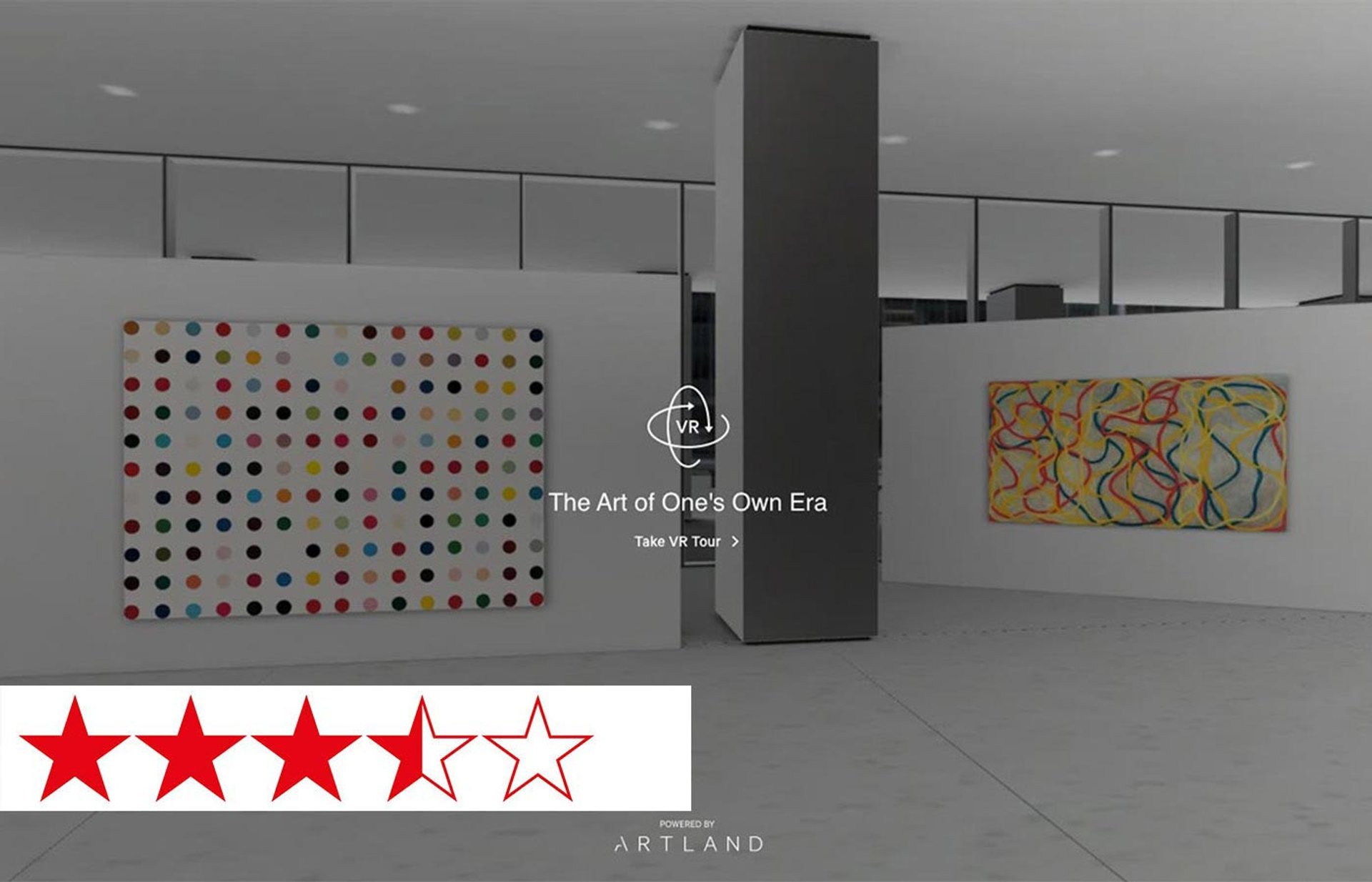
The Art of One's Own Era at UBS's gallery in midtown Manhattan Hirst: © Damien Hirst and Science Ltd. All rights reserved / 2021, ProLitteris, Zurich. Marden: © 2021, ProLitteris, Zurich. UBS Art Collection, © UBS 2021
The Art of One’s Own Era
Created by: UBS Art Collection, using Artland's VRoom technology
The Art of One’s Own Era, an exhibition selected from UBS’s corporate collection—featuring works that came with the Swiss bank's acquisition of the US investment bank and brokerage PaineWebber in 2000—presented in VR on the Artland platform in a virtual recreation of the UBS branch at 1285 Avenue of the Americas, New York City (formerly the PaineWebber building).
The show features the work of 35 artists including Jean-Michel Basquiat, Lucian Freud, Damien Hirst, Alex Katz, Cindy Sherman, Susan Rothenberg and Edward Weston.
Artland’s VRoom tech and product first appeared in the virtual fair the platform created with Untitled Art Fair in August 2020. The platform has added a number of new features in the past 10 months. (You can read the XR Panel's review “Untitled, Art Online fair and Artland: vast data collecting capabilities and some great art” at this link.)
The Art of One's Own Era runs from 21 April to 6 September 2021
Where to find it
- They say:
- The works from the former PaineWebber Collection present a time capsule... of the downtown New York art scene from 1960 to 2000
The Art of One's Own Era exhibition presents a selection of core artworks from the art collection of PaineWebber. The collection now forms an integral part of the UBS Art Collection and was assembled by Donald B. Marron [chairman of PaineWebber], who was a singular figure in the corporate art landscape during the 1980s and 1990s.
The UBS Art Collection’s guiding mission is to collaborate with and collect work by the most significant artists of our time. The works from the former PaineWebber Collection present a time capsule revealing the “who’s who” of artists of the downtown New York art scene from 1960 to 2000.
To show the works, we virtually recreated our UBS Art Gallery—which we had opened in 2019 to make more works from our collection available to the public but which had to close temporarily due to the pandemic. The location at 1285 Avenue of the Americas holds significance as the former PaineWebber building.
The UBS Art Collection aims to collect art that inspires, sparks conversations and provides new perspectives on global issues. The collection has grown to encompass artists representing cultures from around the world and includes iconic art of the last half-century and new acquisitions by emerging talents.
Mary Rozell, Global Head of the UBS Art Collection
Curator's note
We see in this XR experience all the tension of public access alongside the funding of cultural creation and preservation: a private collection, virtually open to the public, on privately run platformsgretchen andrew

The UBS Collection is enormous and maintains its corporate environment UBS Art Collection, © UBS 2021 / Artland
While the art world has become newly, and quite likely temporarily, obsessed with how to handle digitally native works, we on the XR Panel have been focusing on physical art objects and how virtual and augmented technology might be used to increase the accessibility to and appreciation of culture.
We feel the past hype cycles, over-simplified claims of accessibility, conflation of artistic medium with distribution platform, and the optimisation of commerce over culture we’ve historically seen with XR can also provide insight into the current NFT frenzy.
We consider XR to be both a technology and a medium with a more mature relationship to the art world—yet one that is asking similar questions. This panel has been particularly wondering, “How do we nurture and optimise technical development for culture and not just commerce?”
One of XR’s most successful uses has been for the remote art fair, which it should be noted has a positive environmental impact on travel and shipping. We reviewed one such art fair in August of 2020 and this review takes an updated look at the Artland platform.
Beneath the question of technology’s cultural use and development lies an even older quandary that plagues both XR and NFT: how, quite literally, to integrate the financing of art.
It is for this reason we’ve selected UBS’s virtual presentation of its corporate collection for our next review. We see in this XR experience all the tension of public access alongside the funding of cultural creation and preservation: a private collection, virtually open to the public, on privately run platforms.
The exhibition interests us as well because UBS opted to go to each of the 35 artists or their estates to get permission for the virtual exhibition. It is unclear if this permission process will become the standard. I’ve personally defended all digitisation as an artistic process. Though I’m not sure inclusion of an owned, not augmented, work in a VR exhibition should require such a process. Should we as artists and collectors standardise an approval process with all living artists? How do we deal with this for Van Gogh?
I recently had the opportunity to work with Artland’s team to convert my current IRL exhibition at Annka Kultys Gallery into VR. It includes the creation of a custom space that mimics the new gallery space in Hackney, with hip east London "scenery” outside the window and all!
It is worth noting the platform/artist collaboration that Artland’s VR process enables. While it is possible to use Artland and many other VR systems in a plug-and-play capacity, their most interesting value is in the medium-specific and problem solving that takes place between artist and technologist.
Working closely with Nicholas Robinson of Artland to create my exhibition, I found technical choices had curatorial implications and curatorial choices had technical implications. And for this, it’s best to have a partner, not just a product.
Gretchen Andrew, Curator of the XR Panel
We say:
Probably the first time I have seen a physical emulation-style virtualised gallery approach high-enough resolution on the artworks’ reproduction to avoid distractionEron Rauch
Is it accessible?
Carole Chainon: The gallery is easily accessible online from my computer.
Dhiren Dasu: Did not load on to any web browsers on my Windows 10 PC. Worked on my Android phone.

Andreas Gursky's 99 Cent, 1999/2016 (right) and Susan Rothenberg's 1,2,3,4,5,6 (paper), 1988, face out of the VR space into the virtual courtyard beyond Gursky: © Andreas Gursky/Courtesy Sprüth Magers/2021 ProLitteris Zurich. Rothenberg: © 2021 ProLitteris Zurich. UBS Art Collection: © UBS 2021
Eron Rauch: The hanging location of the large Gursky—99 Cent (1999/2016)—was originally baffling to me. It is tucked into a shallow space only (virtual) feet from the building’s glass exterior wall. As I looked out that window, it occurred to me that my bafflement was the product of the eradication of public accessibility through virtuality. Beyond the glass is a large courtyard, depicted with ample space to gather and scattered seating. The Gursky would, in a real-world setting of this show, be visible from this courtyard and to its public(-ish) passers-by. Yet, that interstitial commons was removed by the digital exhibit. Not only in the simplistic sense that we, the user, do not have access to that courtyard, but also that there is no external flow of public people—other real users—to potentially interact with it.
From a critical, art historical standpoint, how good is the art?
A veritable who’s who of groundbreaking artists from the past 50 yearsdhiren dasu
Carole Chainon: As a fan of vibrant and colourful artworks, I love seeing Damien Hirst’s Albumin and Bryce Marden’s Chinese Dancing. We really can get up close, "smell" the paintings and "feel" the sculptures, even more so than we would be allowed to do in real life. This enables us to appreciate the fine details thanks to the quality of the capture.
Dhiren Dasu: The art is excellent and features a veritable "who’s who" of groundbreaking artists from the past 50 years. Many of the works in the collection are historically significant and upended the conventions of contemporary art. Revolution is implicit in the works of Lichtenstein, Basquiat, Lucian Freud and other artists in the collection.
Eron Rauch: It’s a bit hard not to engage with the political economy of “good art” in the case of this show. Before we enter the virtual space, we land on a webpage that explains the work in this show was “integrated throughout the firm’s history of mergers and acquisitions” from another major finance firm. Then a statement about how the firm’s founders felt that art has value because it fosters “innovative thinking”. The pre-shows page has a diversity statement, which is appreciated, but even a cursory glance at the pdf “checklist” shows that only 7 of 35 works are by women, and a vast majority of the works are the usual line-up of top-notch blue-chip bets.
What medium-specific qualities does it employ?
A feeling of having visited the UBS Art Gallery, even if we have never taken steps near or inside the buildingcarole chainon
Carole Chainon: In this experience, we are transported into a recreation of the real-life gallery. The inside is faithfully recreated making us wish we had access to the entire lobby and building. There are halls of elevators that are off-limits, and the paintings in the distance serve as a reminder of the sometimes limited access in these private institutions.
Dhiren Dasu: Given that this collection seems to be housed in the foyer of a bank, access is by definition limited. So VR obviously removes the limitations of both time and space to allow us to see this work albeit on a tiny mobile phone screen. I expect this would be excellent with VR goggles.
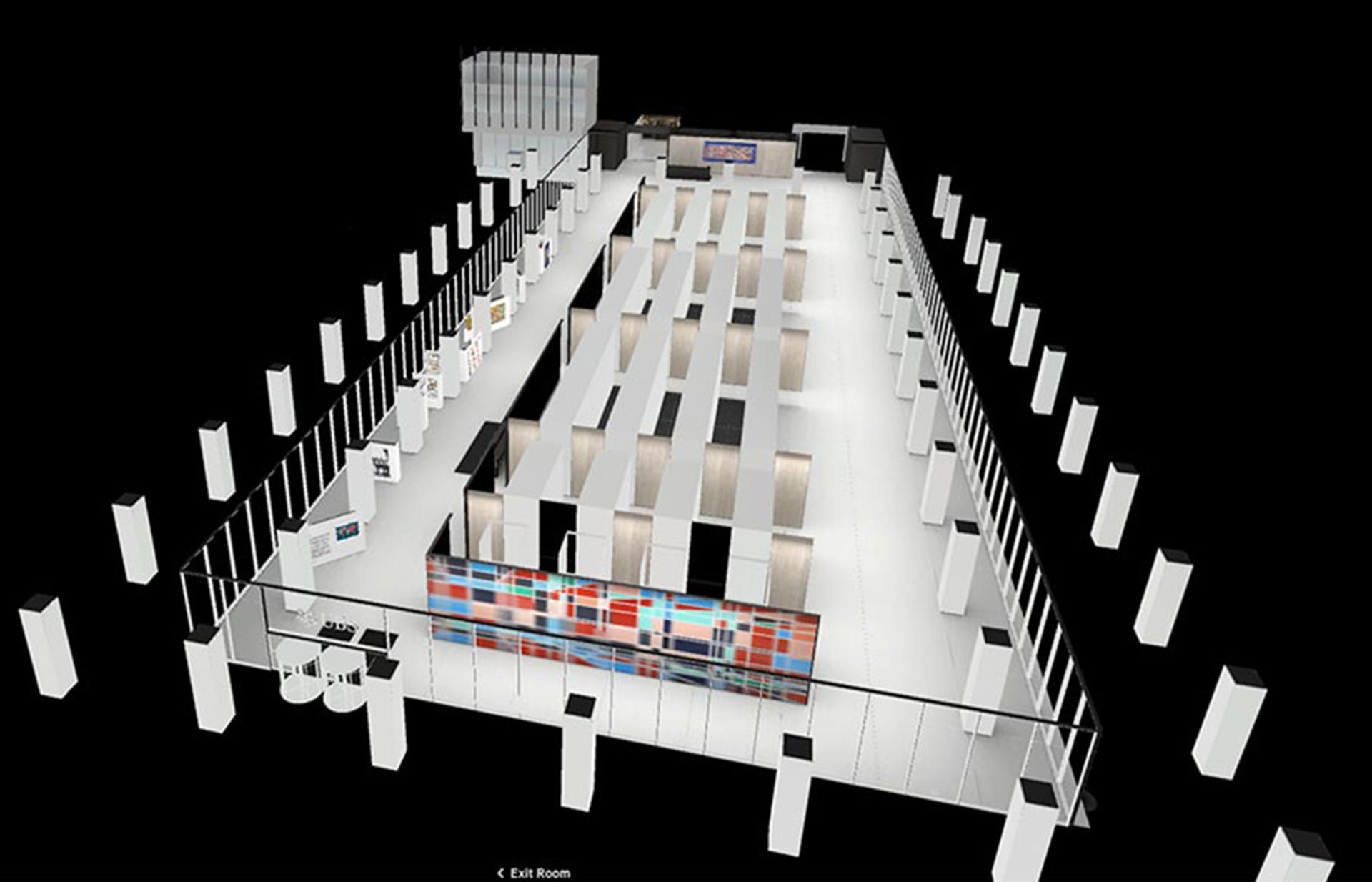
A visual-centric approach to art spaces: the dollhouse view used to navigate the UBS Gallery in VR UBS Art Collection, © UBS 2021
Eron Rauch: In Tobey Crocket’s essay “Computer as Dollhouse”, he suggests virtual spaces are a continuation of dollhouses. (Artland, like other VR platforms, uses a dollhouse view—see above—as a user guide to navigation.) In Crocket's historical overview, he notes that, amongst other things, dollhouses functioned didactically to educate wealthy girls to their supposedly-proper domestic role in society. I increasingly see this sort of virtual show that strictly recreates white gallery norms as a form of similarly constrained norms training. It trains a viewer to a specific, overwhelmingly silent, passive, visual-centric approach to art spaces.
Does it break new ground technically?
Finally a crouch button! No longer are works hung below eye level destined to be stretched into a minimalist-adjacent rhombus!eron rauch
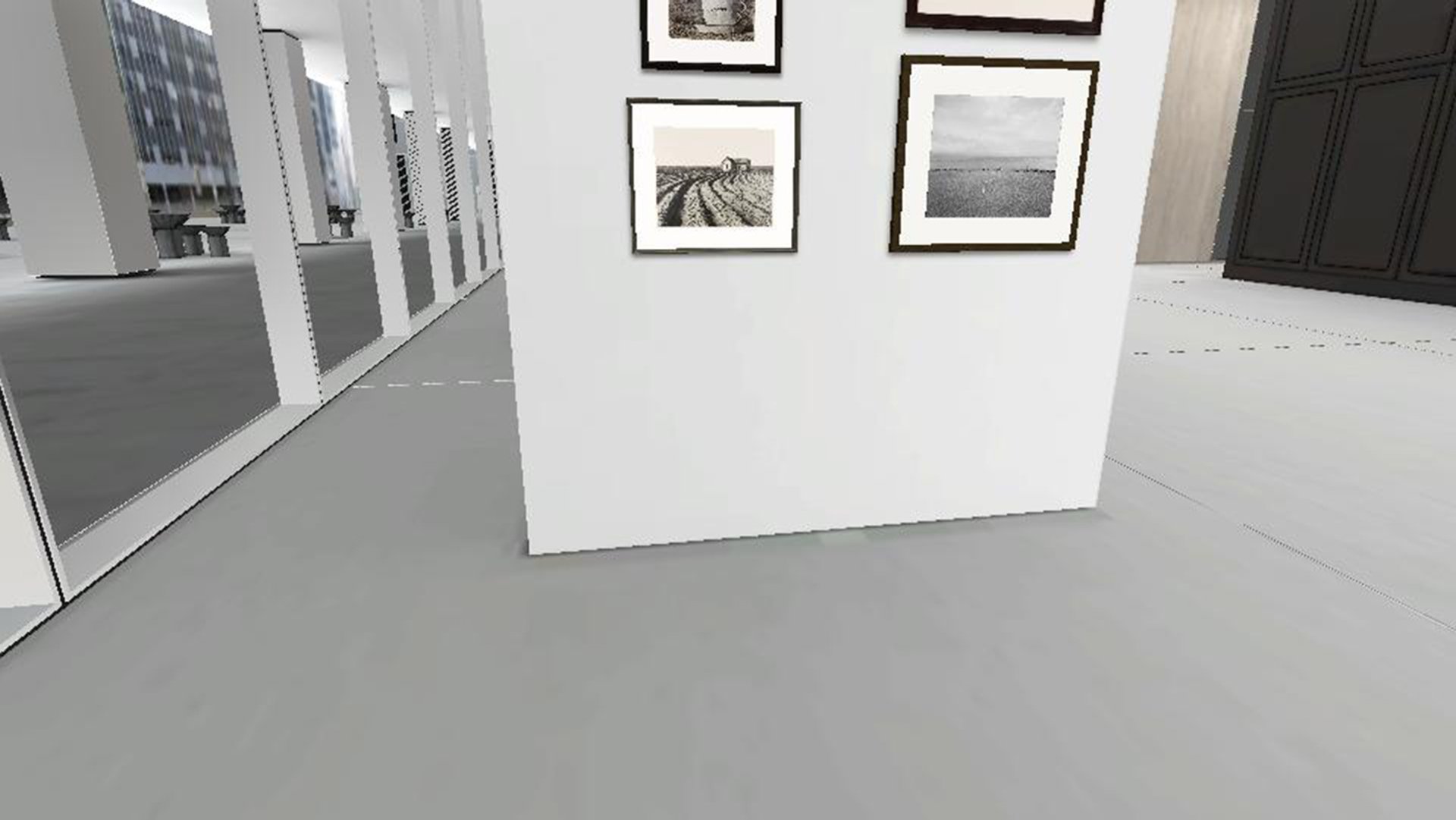
The crouch button—the control key on a laptop—enables viewers to get an undistorted view of images hung below head height, such as Dorothea Lange's Tractored Out, Childress County, Texas, c. 1935 (1938) and Harry Callahan's Cape Cod 1972 (1975) Lange: © Dorothea Lange Collection, the Oakland Museum of California. City of Oakland. Gift of Paul S. Taylor. Callahan: © The Estate of Harry Callahan, courtesy of Pace Gallery. UBS Art Collection, © UBS 2021
Carole Chainon: The experience is hosted by Artland, which we’ve previously written about during our review of Untitled art fair. Like Untitled, UBS’s The Art of One’s Own Era is a very well executed and intuitive experience for the user. Also like Untitled, it uses a point and click system or the WASD keys to navigate the recreated gallery.
Dhiren Dasu: The navigation took me a little while to get used to. However, once I was at ease with the system, I was very impressed with the smooth motion and logical functionality of the user interface. I would definitely rank this as the cleanest and most seamless experience of any of the VR shows we've reviewed thus far.
Eron Rauch: From a purely technical standpoint: Finally a crouch button! No longer are works hung below eye level destined to be stretched into a minimalist-adjacent rhombus! Additionally, this Artland-driven gallery is probably the first time I have seen a physical emulation-style virtualised gallery approach high-enough resolution on the artworks’ reproduction to avoid distraction.
The XR panel's ratings
Carole Chainon gave a rating of 4/5 stars.
Dhiren Dasu gave a rating of 5/5 stars.
Eron Rauch gave a rating of 2/5 stars.
Giving an overall panel rating of 3.5/5 stars
Gretchen Andrew recused herself from giving a star rating as Artland is hosting a VR version of her show at Annka Kultys Gallery.
The Art Newspaper’s XR Panel
Gretchen Andrew is a "Search Engine Artist" and an "Internet Imperialist" who hacks powerful systems with art, code and glitter. You can see her current VR exhibition on Artland.
Dhiren Dasu is a digital media creator and consultant. His areas of speciality include photography, film, virtual space, graphic design, visual effects, animation and audio production. Dasu, in his fine art persona as Shapeshifter7, makes artworks that echo and recompose the architectural spaces he photographs, turning them into immersive spaces while exploring the nexus of photography, collage, symbols, and perception.
Carole Chainon is the co-founder of JYC, an XR development and production studio based in Los Angeles with a presence in Europe, creating XR experiences for the entertainment and enterprise sector. She is also a Spark AR creator.
Eron Rauch is a writer at Riot Games, an artist and curator whose projects explore the infrastructure of imagination, with a focus on subcultures, video games and photography history.


